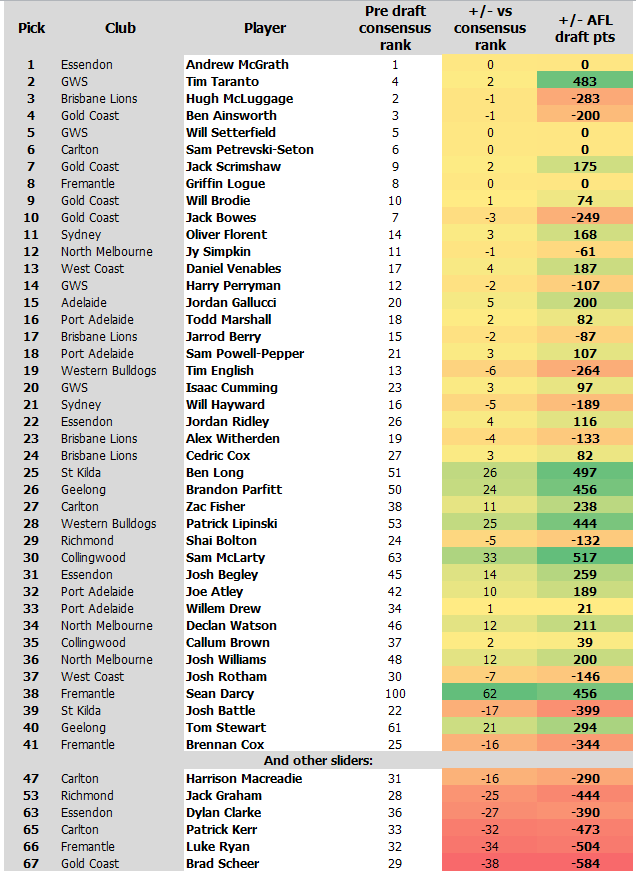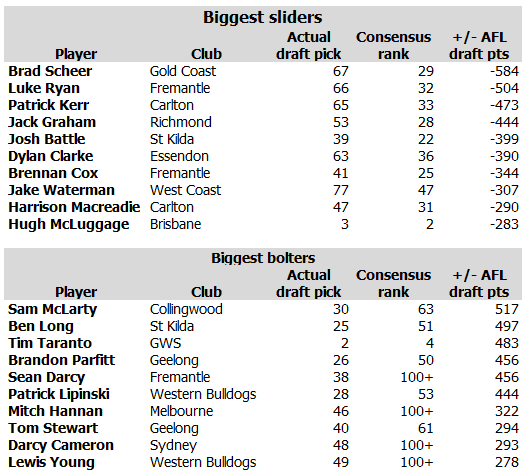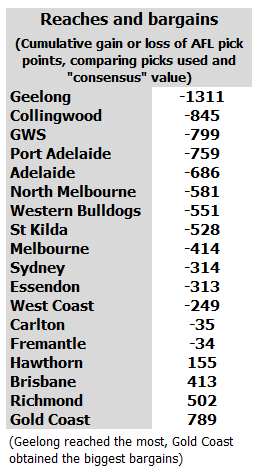Yesterday HPN continued our series of Consensus Phantom Draft posts by looking at how the experts did in their phantom drafts, rating them on how close they were to predicting the actual draft. Today we are going to use the data we obtained from these phantom drafters to assess which players were taken earlier or later compared to the expert draft-watcher consensus.
The theory here is that the wisdom of the expert crowd tells us where players were expected to go. This provides an implicit judgement on each player’s “value” compared the rest of the draft pool – if a player goes higher or lower they can be considered as “bolters” or “sliders”. Here’s how the first two rounds look, showing where consensus ranked players versus where they were actually taken.

We have also quantified the gap in terms of the AFL’s draft pick points system, to provide another view of the gap between expert expectations and draft pick reality. These help illustrate the size of the movement of players in terms other than just a count of pick positions. For example, if a player slides from the fringes of the top 10 to the edge of the first round (Tim English), it is much more significant than a player sliding a similar distance from the start of the second round to the middle (Shai Bolton).
The comparison of Ben Long and Brandon Parfitt with Tim Taranto can also serve as an illustration. The first really big “reaches” by clubs came in the mid 20s with St Kilda taking Ben Long (consensus rank 51) at 25 and Geelong taking Brandon Parfitt (consensus 50) at 26. Tim Taranto’s consensus position was pick 4 and his actual selection came at draft pick 2. But in draft pick points terms the difference between the Long and Taranto gaps were fairly similar.
Below is a list of the largest bolters and sliders among the draftees, sorted according to the gap in AFL draft pick points:

Brad Scheer, rated around 26, was bid on much later than expected, getting to the Gold Coast at pick 67. For them, the valuation in draft pick points is not merely theoretical. The Suns were expected to have to go into points deficit to obtain Scheer, and his slide has saved them a hit on their 2017 pick positions.
Luke Ryan, Patrick Kerr and Jack Graham were all generally expected to be taken in the second round and instead fell to the 50’s or 60’s, becoming bargains for the clubs which eventually took them.
On the bolter side, Sam McLarty for Collingwood at 30 was the single biggest mover, coming from a consensus ranking at the fringes of the draft at pick 63. A number of players were not considered in most experts’ calculations and are thus also bolters from the very notional 100+ ranking range (about 150 players were mentioned in at least one phantom draft). Two very left-field players not included in a single phantom draft were Melbourne’s Mitch Hannan (pick 46) and Sydney’s Darcy Cameron (pick 48).
In fact, both of Melbourne’s picks (Hannan and Dion Johnstone) were so left field that they were included in no phantom drafts. This is a phenomenal act of drafting from obscurity in the modern information age of drafts.
The flipside of the feelgood story of the draft bolter is a club that can be considered to have “reached” past higher rated players to get them. We can use the gap between expectation and reality to rank which clubs, overall, got the biggest bargains or made the biggest reaches:

(Note that a majority of clubs shape as losing value due to the well-rated players that went undrafted)
Geelong and Collingwood both took multiple players expected to go later in proceedings and emerge as the biggest “reachers” of this year’s draft. Time will tell whether the likes of Sam McLarty, Kayle Kirby, Tom Stewart and Brandon Parfitt will prove to be astute pickups or lost opportunities.
Alongside Gold Coast who secured Bowes and Scheer cheaply, Richmond and Brisbane also look like big winners in terms of having bargains slide through to them. Those were Jack Graham and Shai Bolton for Richmond and Hugh McLuggage and Alex Whitherden for Brisbane.
Hawthorn, by sheer virtue of having such worthless late picks thanks to swapping everything for O’Meara, also notionally obtained a “slider” in Harry Morrison, rated 56th and drafted at 74.
Finally, here’s a look at the value that was “left on the table” – the players who were reasonably well rated, but went undrafted:

Many of these overlooked players subsequently went as rookies, but noteworthy players left outside the AFL system for 2017 include Jonty Scharenberg who was rated 41st by the average expert and Sam Walker who was rated 43rd. Bailey Morrish, Hamish Brayshaw, Brodie Romensky and Liam Ryan were also seen as fringe national draft shots, and yet they fell through the rookie draft as well.
Only four players selected in the Under 18 All Australian Team missed selection entirely; the aforementioned Scharenberg and Walker, as well as the sad case of Alex Villis and underage prospect Sam Hayes.
